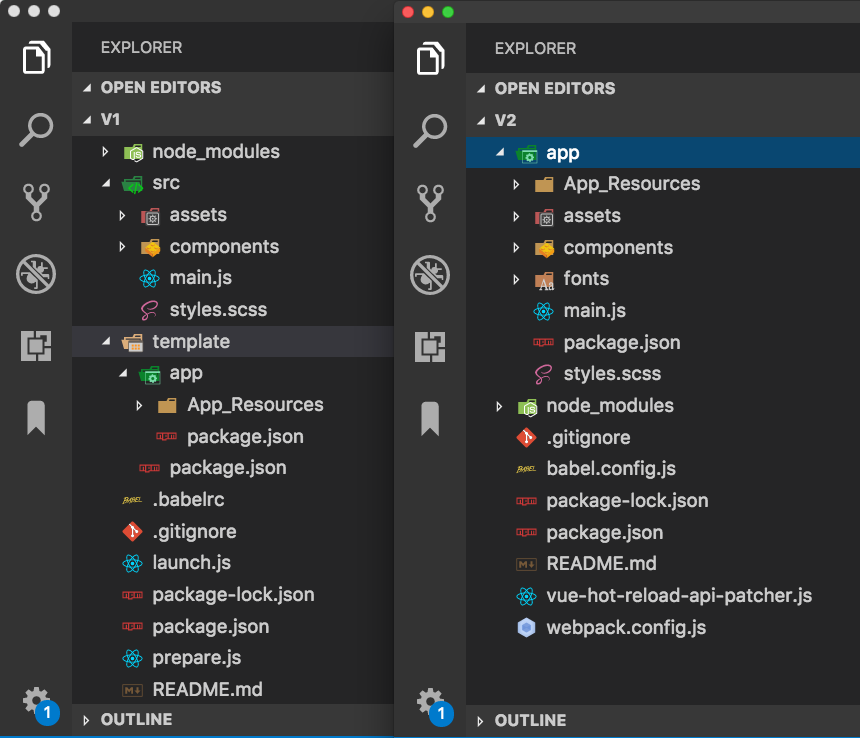- elements:utilities
- introduction
- getting-started
- routing
- utilities
- elements:layouts
- elements:action-bar
- elements:components
- elements:dialogs
- elements:utilities
Estimated time for the upgrade: 10-20 minutes.
If you scaffolded a NativeScript-Vue app using the 1.3.1 version of the Vue-CLI template, it's time to upgrade to the newest 2.0 version. This guide will help you do that.
Upgrade overview
The new template has a different folder structure:

The simplified upgrade process involves:
- Creating a new project from the updated template.
- Copying files from your old app into the new one.
- Rearranging and adding some files.
Step 1: Create new app
Use the Vue-CLI template to create a new app. Make sure to run the same preinstallation commands that you used for the old version. For example, if you installed Vuex in the CLI the first time, do it again now.
Run the following command to create a new project from the Vue-CLI template.
$ npm install -g @vue/cli @vue/cli-init
$ vue init nativescript-vue/vue-cli-template <project-name>
$ cd <project-name>
$ npm install
$ tns preview
$ # or
$ tns runStep 2: Replace App_Resources
iOS: Copy your old app's ./template/app/App_Resources/iOS folder. Then, paste it into the new app's app/App_Resources folder. Make sure that you're replacing the new App_Resources/iOS folder.
Android: Copy all the contents of your old app's ./template/app/App_Resources/Android folder. Next, paste it into the new app's app/App_Resources/Android/src/main/res folder.
Step 3: Merge the src and app folders
Copy all the folders in src from your old app and paste them into the app folder in the new app.
If you have custom fonts, move the contents of the src/assets/fonts folder to app/fonts. This ensures that NativeScript will load your custom fonts automatically.
Step 4: Edit main.js
Edit main.js's Vue initialization block to resemble:
new Vue({
render: h => h('frame', [h(HelloWorld)]),
}).$start();NativeScript 4.0 brings two major improvements:
- a new
<Frame>element - a new way to change the root element of your app that lets you share common view elements across pages (navigations).
Before NativeScript 4.0, the root element was a <Frame> element which was implicitly created by NativeScript when the application started.
With the latest changes, <Frame> and <Page> elements are no longer automatically created. So, in NativeScript-Vue 2.0.0, you need to explicitly add these elements to your template.
To keep the previous behavior of having a single root <Frame>, you can change your root Vue instance to have a <Frame> and a <Page> element.
Example: Adding <Frame> and <Page> to the template
// in older versions
// this automatically created a Page
new Vue({
template: `<Label text="Hello world"/>`
}).$start()// in NativeScript-Vue 2.0.0
// the <Frame> and <Page> must exist in your template
new Vue({
template: `
<Frame>
<Page>
<Label text="Hello world"/>
</Page>
</Frame>
`
}).$start()This lets you use a shared element across different pages.
Example: Using a shared <SideDrawer> element
new Vue({
template: `
<RadSideDrawer>
<StackLayout ~drawerContent>...</StackLayout>
<Frame ~mainContent>
<Page>
<Label text="Hello world"/>
</Page>
</Frame>
</RadSideDrawer>
`
}).$start()Step 5: Edit paths
Because the folder structure has changed, you need to edit the paths in your new app to point to your styles, fonts, and images.
Example: Changing image references
In your old app, you are likely to have referenced images like this.
<Image v-if="surprise" src="~/images/NativeScript-Vue.png"/>To ensure that NativeScript loads the images, change the path reference to the following.
<Image v-if="surprise" src="~/assets/images/NativeScript-Vue.png"/>(If needed) Step 6: Fix manual routing props
If your app uses manual routing, the syntax for passing props has changed. Note that this change might not be required in all projects.
Your old syntax is likely to look like this.
this.$navigateTo(NewPage, {
transition: {},
transitioniOS: {},
transitionAndroid: {},
context: {
propsData: {
name: this.name,
value: this.value
}
}
});To preserve the manual routing behavior in your new app, change your syntax to the following:
this.$navigateTo(NewPage, {
transition: {},
transitioniOS: {},
transitionAndroid: {},
props: {
name: this.name,
value: this.value
}
});Step 7: Align package.json
Copy the relevant values from your old app's root package.json file into the new app's root package.json file.
You will likely need to copy the Dependencies: block and, in some cases, realign the new app's app version and description at the top of package.json.
Step 8: Clean and run
Run the following command to clean the new app's folders and reinstall any dependencies.
$ cd <project-name>
$ rm -rf platforms
$ npm install
$ tns run(Optional) Step 9: Try HMR
NativeScript now provides support for HMR (Hot Module Replacement). The latest version of NativeScript-Vue provides out-of-the-box HMR support as well but requires the NativeScript CLI.
Run the following command to get HMR support by installing the latest and greatest version of the NativeScript CLI.
$ npm install -g nativescript@next
$ cd <project-name>
$ rm -rf platforms
$ tns run

